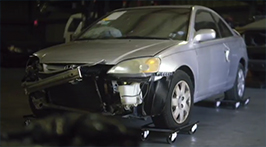Pacifiers are typically introduced to young babies from 0 to 6 months of age as a calming method. Pacifiers typically consist of a nipple, a mouth shield, and a handle or a ring for the child to grasp. The nipple is generally made of latex, silicone, or plastic. The mouth shield and handle should be large enough not to present a choking hazard to the child.
Defective Pacifiers
Pacifiers that separate into pieces easily present an extreme choking and suffocation hazard to babies and young children. Sometimes, the mouth shield is not large enough to prevent the possibility of it entering the child’s mouth. The handles or rings can be longer than is permitted by regulations on some pacifiers, allowing the pacifier to become jammed into the child’s mouth and throat in the event that the child turns over or tumbles with the pacifier. Any pacifier that does not comply with government standards for the manufacturing of pacifiers, as set forth in the Code of Federal Regulations Title 16 Part 1511, is subject to recall and taken off the market.
Federal Regulations Regarding Pacifiers
Federal regulations for the manufacturing of pacifiers were put into place by the CPSC in 1978 following eight infant deaths related to pacifiers. Requirements for the manufacturing of pacifiers include regulations regarding shield or guard requirements, protrusions or handles, attachments such as ribbons or strings, labeling requirements, and metric requirements. In addition, a pacifier will be subject to a structural integrity test to ensure its durability before it is allowed on the market.
Death Statistics Related to Pacifiers
Between 1970 and 1975, at least eight deaths were connected to pacifiers. Six of the deaths were caused by strangulation as a result of the ribbon or string placed around the child’s neck to secure the pacifier. One death was reported to have been suffocation when the pacifier disassembled and became lodged in the child’s throat. Another infant death resulted from suffocation when the pacifier stimulated vomiting.
Examples of Defective Pacifiers
Examples of defective pacifiers that have been recalled include:
-
“Bobby Chupete” Pacifiers
In November 2009, Grand World Inc. of Maspeth, New York, recalled approximately 641,000 units of its “Bobby Chupete” Pacifiers. The mouth guard on the pacifier did not meet with federal safety standards and posed a choking hazard. The pacifiers have a latex nipple, a ring handle, and a heart-shaped mouth shield. They were available in red, aqua, yellow, and white. The “Bobby Chupete” Pacifier was sold between November 2004 and July 2009 at retail stores nationwide.
-
Jaloma Pacifiers
In July 2009, Gromex Inc. of Passaic, New Jersey, recalled approximately 700 units of Jaloma Pacifiers as a result of a failure to comply with federal safety standards regarding the manufacturing of pacifiers. The mouth shield and ventilation holes of the pacifier were too small. The word “Jaloma” can be read on the side of the mouth shield, and the pacifier has a ring handle and round guard with two ventilation holes. It was sold in New York and New Jersey in retail stores from February 2008 to March 2009.
-
Healthtex Zoo Pacifiers
In April 2009, Healthtex of Miami, Florida recalled approximately 40,000 units of its Zoo Pacifiers as a result of a failure to comply with federal safety standards regarding the manufacturing of pacifiers. The base and nipple of the pacifier can separate easily, presenting a choking hazard. The Zoo pacifiers feature cartoon animal handles, a round mouth guard, and three ventilation holes. “Made in Spain” is visible on the handle. In addition, the words “Mi Tosoro” are printed on the package. These pacifiers were distributed in supermarkets and pharmacies across the nation between December 2002 and March 2009.
-
Le Roy Pacifiers
In June 1993, hundreds of Le Roy Pacifiers that had been distributed in the San Francisco Bay area between February 1993 and April 1993 were recalled. These pacifiers could easily disassemble during use, presenting a choking hazard. The pacifiers were available in blue, pink, and ivory, with “Le Roy” embossed on the mouth shield. Le Roy pacifiers do not meet with federal safety standards regarding the manufacturing of pacifiers. These pacifiers were manufactured in Mexico and sold to merchants from the back of a van. U.S Customs was contacted anonymously regarding this issue.
Resources
- http://www.recalls.gov/
- http://cpsc.gov/
- http://yosemite.epa.gov/ochp/ochpweb.nsf/content/news2.htm#recalls
Bobby Chupete Pacifier Recall
On November 18, 2009, the U.S. Consumer Product Safety Commission and Grand World Inc. announced a voluntary recall of approximately 641,000 “Bobby Chupete” pacifiers due to a failure to meet federal safety standards. The defective pacifiers pose a choking hazard to infants and toddlers, due to the small size of the mouth guard.
The recall affects “Bobby Chupete” pacifiers with a ring-shaped handle, heart-shaped mouth guard, and two ventilation holes. The pacifier nipple is made of latex, and the pacifier was sold in aqua, red, white, or yellow colors. The packaging features a picture of an infant.
The recalled pacifiers were sold in retail stores nationwide from November 2004 through July 2009. Consumers are advised to immediately take the pacifiers away from infants and toddlers and contact Grand World at 718-326-7786 for a refund or replacement pacifier.
